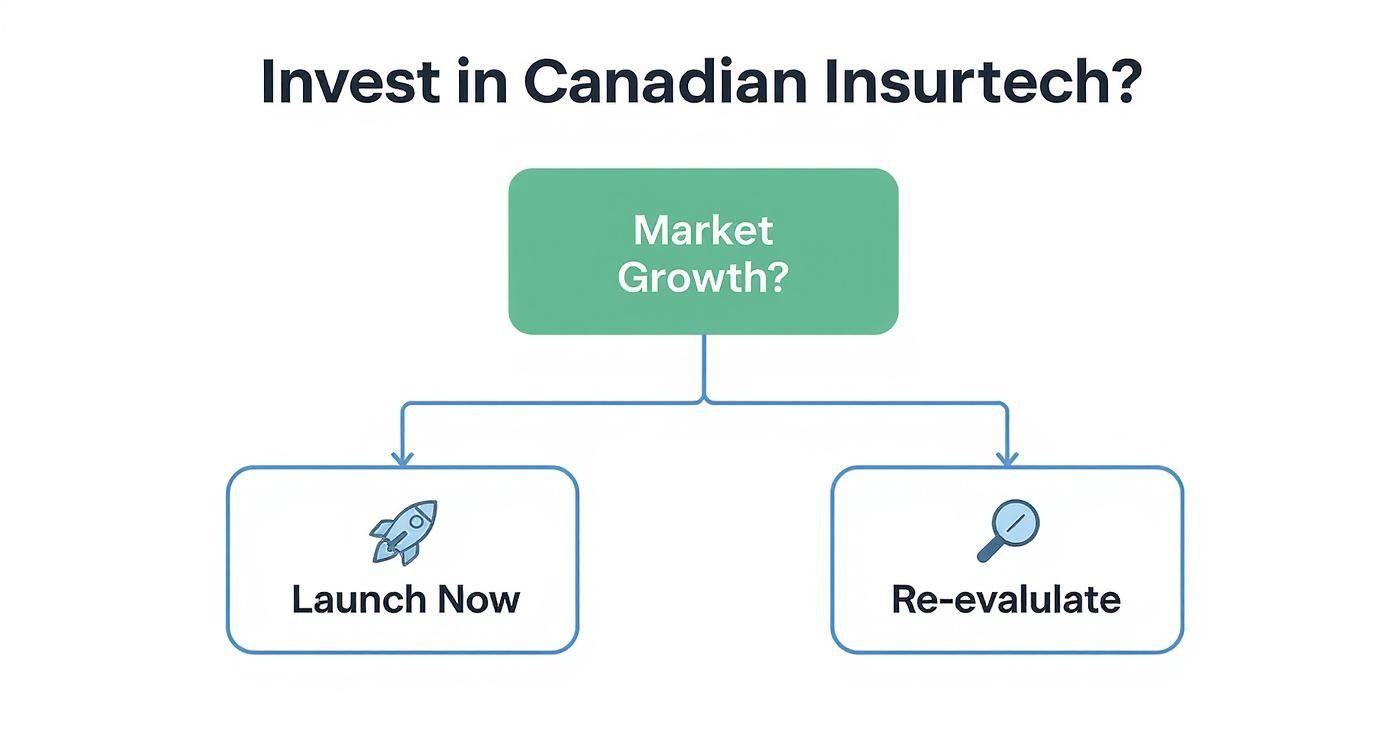Insurtech software development in Canada is more than just a trend; it's a fundamental shift, pulling a traditionally cautious industry into the digital age. This change is all about a pressing need for smarter operations, better efficiency, and a customer experience that actually feels modern. It’s creating a massive opportunity for established insurers and new startups alike to build the next wave of digital insurance tools.
Understanding The Canadian Insurtech Boom
Think of the Canadian insurance market like a quiet, old-school harbour that's suddenly transforming into a bustling, high-tech port. For years, the industry chugged along with paper-heavy, manual processes. Now, a powerful digital tide is rolling in, forcing insurers to completely rethink how they handle everything from underwriting and claims to simple customer interactions. This isn't just about putting old forms online; it's about engineering systems that are faster, smarter, and far more responsive.
Several key factors are driving this evolution. Legacy insurers are finally starting to lean into technologies like artificial intelligence (AI), machine learning (ML), and even blockchain. They're using them to automate repetitive tasks, analyse risk with incredible precision, and offer products tailored to individual needs. This isn't just a "nice to have"; it's a strategic move to stay relevant as customer expectations continue to rise.
The Financial Momentum
If you want proof of the sector's potential, just follow the money. The Canadian insurtech market, currently valued around at USD 206 million, is on track to hit an incredible USD 3,532.94 million by 2033. That’s a compound annual growth rate (CAGR) of about 32.87%, a figure that shows just how much confidence investors have in this space. For more context on these numbers, the IMARC Group’s report offers a detailed breakdown.
This flood of investment is sparking innovation nationwide, with hubs like Ontario and Quebec leading the charge. These provinces are becoming hotbeds for insurtech software development in Canada, creating ecosystems where agile startups and industry giants can work together on tough challenges. It’s a dynamic environment that makes right now the perfect time to build a new digital insurance platform. You can get a broader perspective by reading our guide to Canadian insurance technology.
Let's break down the key market drivers with a quick overview.
Canadian Insurtech Market at a Glance
This table provides a high-level summary of the key market drivers and statistics shaping the insurtech sector in Canada.
| Metric | Key Figure/Trend |
|---|---|
| Market Valuation | Approx. USD 206 million (current) |
| Projected Growth | USD 3,532.94 million by 2033 |
| CAGR | 32.87% (2024-2033) |
| Key Technologies | Artificial Intelligence (AI), Machine Learning (ML), Blockchain, Big Data Analytics |
| Primary Drivers | Demand for digital customer experiences, operational efficiency, cost reduction |
| Innovation Hotspots | Ontario and Quebec |
This rapid growth isn't just about impressive numbers; it's a direct result of the real-world advantages that technology brings to the table.
The Competitive Advantage of Technology
At its heart, this boom is about the tangible results technology delivers. By building and integrating modern software, insurers are seeing huge gains in both how they operate and how their customers feel about them.
-
AI-Powered Underwriting: Instead of relying solely on manual review, machine learning algorithms can sift through massive datasets to assess risk far more accurately and in a fraction of the time. This leads to fairer pricing and faster policy approvals.
-
Automated Claims Processing: AI can manage the initial claim submission, cross-reference information, and even greenlight simple claims in minutes. This cuts down on administrative overhead and gets money into customers' hands when they need it most.
-
Enhanced Customer Experience: Modern platforms give customers what they expect: self-service portals, easy-to-use mobile apps, and AI chatbots for instant support. It means 24/7 access and control over their policies.
The current market isn’t just about digitising old processes. It’s about using technology to create entirely new business models and value propositions that were previously impossible, setting a new standard for the entire industry.
Ultimately, the Canadian insurtech boom is a direct answer to a clear market demand. Customers want frictionless digital interactions, and insurers desperately need more efficient ways to run their businesses. This intersection of need and capability has created a perfect storm for growth, making insurtech software development Canada a top priority for any insurance company that plans to thrive in the years ahead.
Navigating Canada's Regulatory and Compliance Waters
Think of building an insurtech solution in Canada as navigating a series of intricate waterways. You absolutely need the right charts to avoid running aground. The country's mix of federal and provincial laws creates a layered compliance landscape, and you have to get it right from the very first line of code. This isn’t just about ticking boxes to avoid penalties; it’s about earning the trust of your users and ensuring your platform has a future.
The big one at the federal level is the Personal Information Protection and Electronic Documents Act (PIPEDA). This law is the bedrock of Canadian data privacy, dictating how any private company collects, uses, and shares personal information. If your insurtech platform touches customer data – and it will, from names and addresses to sensitive policy details – PIPEDA is not optional.
What this means in practice is that you can’t just bolt on a privacy policy at the end. Principles like consent, accountability, and defining a clear purpose for data collection need to be woven directly into your software's architecture from day one.
The Provincial Patchwork
While PIPEDA sets the national baseline, you can't stop there. Canada's provinces have their own rules, and you have to follow the ones that apply to where you and your customers are.
-
Alberta and British Columbia: These provinces have their own Personal Information Protection Act (PIPA). If you’re operating within their borders, their specific rules for provincially regulated organisations apply.
-
Quebec's Law 25: This is the heavyweight champion of Canadian privacy law. It’s a significant piece of legislation that strengthens how personal information is handled, giving individuals new powers like the right to data portability and requiring privacy impact assessments for new projects.
A one-size-fits-all compliance strategy simply won't cut it here. Your insurtech software development Canada plan needs to be nimble enough to adapt to these regional differences.
We always advise clients to embrace a 'privacy by design' approach. It means you're building data protection into the very core of your software from the earliest design stages, not trying to add it on later. It’s a proactive mindset that both ensures compliance and builds incredible trust with your users.
If you're weighing the decision to enter the market, this decision tree helps map out the key factors against market growth.

As the visual shows, a strong growth forecast points directly toward launching, backing up the opportunities we’re seeing across the board.
Don't Forget OSFI
Things get even more interesting if your game plan involves partnering with a major national insurance company. These are federally regulated financial institutions (FRFIs), which means another regulator enters the picture: the Office of the Superintendent of Financial Institutions (OSFI).
OSFI has its own detailed guidelines, particularly around technology and cybersecurity risks. Guideline B-13, for instance, lays out clear expectations for how these institutions manage tech and cyber threats. This means your software will be put under a microscope, examined for its security protocols, data handling practices, and how it would respond to an incident. If you want to land those big enterprise deals, your development team needs to be ready to meet this higher bar. For a deeper dive, check out our guide on AI and data privacy in insurance.
Turning all this legal complexity into a clear, actionable roadmap is where the real work begins. A successful launch depends on translating these legal principles into software features that are secure, functional, and user-friendly. It’s a challenge, for sure, but this rigorous framework is precisely what helps create a trustworthy and resilient insurtech ecosystem in Canada.
Choosing the Right Tech Stack for Your Insurtech Platform
Alright, let’s get into the nuts and bolts of building your insurtech platform. This is where the vision starts to become a reality. Think of it like deciding on the blueprint for a custom-built house – the choices you make now will determine how strong, flexible, and future-proof it is. The very first big decision is your core architecture: monolithic or microservices?
A monolithic architecture is like an all-in-one smart home. Every function, from the security system (user authentication) to the kitchen appliances (policy management) and plumbing (claims processing), is part of one single, interconnected unit. It's often quicker to get up and running, but making a small upgrade to the kitchen might accidentally mess with the security system. It can get clunky and risky to modify as you grow.
On the other hand, a microservices architecture is more like a connected estate with separate, specialised buildings. You have one building for payments, another for user profiles, and a third for notifications. Each one runs independently. This setup lets you upgrade, scale, or even completely rebuild one part without touching anything else. For an insurtech solution that needs to adapt and evolve, microservices usually offer the agility you need.
Assembling Your Core Components
Once you’ve picked your architectural style, it’s time to choose the actual building materials – the technologies that will power your platform. A modern insurtech stack is built in layers, and each one has a specific job to do.

Here's what a typical setup looks like:
-
Frontend (The User Interface): This is the "storefront" that your customers and brokers interact with. Modern frameworks like React or Angular are fantastic for building snappy, intuitive experiences that look great and work perfectly on any device, from a desktop to a smartphone.
-
Backend (The Engine Room): This is where all the heavy lifting happens behind the scenes. Node.js is a great choice if you need real-time features, like instant notifications. If you're planning to use AI for things like fraud detection or sophisticated risk modelling, Python is the undisputed champion.
-
Database (The Foundation): This is where all your mission-critical data lives. For structured, transactional data like policy details, a rock-solid option like PostgreSQL is ideal. If you need more flexibility to handle varied data types, something like MongoDB might be a better fit.
-
Cloud Infrastructure (The Location): This is the secure, digital space where your application resides. Big players like Amazon Web Services (AWS) or Microsoft Azure provide the robust, scalable, and compliant environment you need to handle sensitive insurance data in Canada.
The right tech stack is more than just a list of popular tools. It’s about creating a strategic combination of technologies that work in harmony to build a secure, high-performing system designed for the unique demands of the insurance world.
This thoughtful approach is critical, especially when you look at the numbers. The Canadian insurance market is on track to hit around USD 164.73 billion in gross written premiums, with a projected compound annual growth rate of 5.32% through 2030. A huge part of that growth is coming from technology. Direct digital sales channels are expected to blow past USD 50 billion by 2030, all thanks to modern APIs and automation.
Making the Right Technology Choices
Every insurtech software development Canada project hinges on making smart technology choices. It’s tempting to grab the latest shiny object, but it’s far more important to pick tools that fit your business goals, your team's skills, and your plans for growth. These decisions will have a direct impact on how well your platform performs, how much it costs to maintain, and how easily you can adapt down the road.
Each piece of the puzzle has a purpose, and you need to see how they fit together. For instance, if your roadmap includes machine learning for predictive analytics, a Python backend is a no-brainer. But if real-time chat support for brokers is a day-one priority, Node.js might be the smarter play. This requires careful thinking and a solid product plan. For a deeper dive into this process, have a look at our step-by-step guide on selecting the right tech stack. Getting this right from the start ensures you build something that's not just powerful, but built to last.
Integrating New Solutions With Legacy Insurance Systems

One of the toughest hurdles in any insurtech software development Canada project isn't dreaming up the new features; it's getting them to talk to the old systems. Many Canadian insurers run on platforms that are decades old, yet these systems are the bedrock of the business, holding invaluable policy and claims data.
Tackling this is like renovating a heritage home. You want to install smart technology and modern amenities, but you have to do it without knocking down the load-bearing walls. These legacy systems, often built on mainframe technology and coded in languages like COBOL, are the operational heart of the company. You can't just flip a switch and replace them. The real skill lies in building a solid bridge between these reliable workhorses and your new, nimble, cloud-based applications.
The Power of an API-First Strategy
The smartest way to build that bridge is with an API-first development strategy. Think of Application Programming Interfaces (APIs) as universal translators. They create a common language that lets a brand-new mobile app speak fluently with a 40-year-old mainframe. This way, the app can pull up policy details or file a claim without either system needing to understand the other's internal architecture.
This approach effectively separates your customer-facing front-end from the complex back-end. It frees up your development team to create fantastic user experiences with the latest tools, all while the legacy core keeps humming along, doing its job. For any insurer navigating this path, exploring strategies for integrating agile front-end with waterfall back-end systems is a critical step.
Adopting an API-first mindset isn't just a technical choice; it's a business strategy. It transforms legacy systems from a roadblock into a secure, accessible data source, unlocking decades of valuable information for modern applications.
This isn't about a risky, all-or-nothing overhaul. It's about a gradual, controlled modernisation that breathes new life into your existing infrastructure.
Choosing the Right Integration Method
Depending on your legacy system's architecture and your project goals, there are a few proven ways to make this connection work. Each method has its own strengths and is suited for different scenarios.
The table below breaks down the most common approaches:
Legacy System Integration Approaches
| Integration Method | Description | Best For | Key Challenge |
|---|---|---|---|
| API Gateway | A central management layer that exposes legacy functions as modern REST or GraphQL APIs. | Creating a unified, secure entry point for multiple new applications to access various legacy services. | Initial setup complexity and potential to become a single point of failure. |
| Middleware / ESB | An "Enterprise Service Bus" acts as a central hub, translating data formats and protocols between systems. | Complex environments with many disparate systems (e.g., policy, billing, claims) that need to communicate. | Can be expensive to implement and maintain; adds another layer of complexity. |
| Direct Database Connection | New applications connect directly to the legacy system's database to read or write data. | Simple data retrieval needs where real-time access is critical and the database structure is stable. | High risk; tightly couples the new and old systems, making future changes difficult. |
| Batch File Transfer | Data is extracted from the legacy system periodically (e.g., nightly) and sent to the new system as a file. | Non-real-time processes like reporting, analytics, or migrating large volumes of data. | Data is not up-to-date, which is unsuitable for customer-facing applications. |
Ultimately, many projects use a hybrid approach, picking the right tool for the right job to ensure a smooth and stable integration.
Middleware and Phased Rollouts
Another key piece of the integration puzzle is middleware. This software layer sits between your new app and the legacy system, acting as a traffic controller and translator. It can handle heavy lifting like reformatting data, managing message queues, and converting protocols, which smooths out the whole communication process.
To avoid any major business disruptions, a phased rollout is the only way to go. Instead of a risky "big bang" launch, you introduce new functionality piece by piece.
-
Start Small: Begin with a pilot program for a low-risk business segment, like a single insurance product or a specific group of brokers.
-
Listen and Learn: Use this initial phase to iron out bugs, gather real-world user feedback, and fine-tune the integration.
-
Expand Methodically: Once you're confident, gradually roll out the new solution to more users and departments, ensuring everything remains stable at each step.
This careful, step-by-step process builds trust within your organisation and guarantees that daily operations continue without a hitch. It’s a pragmatic approach that respects the value of your existing systems while fully embracing the future.
Estimating Costs and Timelines for Your Insurtech Project
So, how much is this all going to cost, and when can you launch? Nailing down a realistic budget and timeline is arguably one of the most important steps in any Canadian insurtech project. Get this right, and you'll have the clarity you need to build a solid business case and manage your investment wisely. Get it wrong, and even the best ideas can run out of steam.
The path from a great idea to a product people actually use isn't a single leap. It's a series of deliberate steps. Most projects start by building a Minimum Viable Product (MVP). Think of it as the essential, core version of your software – just enough to solve a key problem, attract those first crucial customers, and prove your concept before you go all-in with a bigger budget.
Breaking Down the Costs of an Insurtech MVP
For a typical insurtech MVP here in Canada, you should be prepared for a budget somewhere in the $75,000 to $150,000 range. Of course, this can climb higher depending on how complex your idea is. This initial investment gets spread across several critical phases. For a deeper dive into how software project costs are calculated, this guide to mobile app development costs is a great resource.
Here’s a rough sketch of where that money usually goes:
-
Discovery and Strategy (10-15%): This is your foundation. It’s all about deep market research, sizing up the competition, figuring out who your users are, and creating a detailed blueprint for the project. Skipping this step is a classic way to make expensive mistakes down the road.
-
UI/UX Design (15-20%): This is where your vision starts to look and feel real. The design team builds wireframes, mockups, and clickable prototypes to ensure the final product is intuitive and easy to use – both for your customers and your own staff.
-
Development and Coding (50-60%): The bulk of the budget lives here. This covers the heavy lifting of writing the code for the front-end (what users see) and the back-end (the engine), setting up the database, and connecting to other essential services like payment gateways or old-school policy systems.
-
Testing and Quality Assurance (10-15%): In insurance, you can't afford glitches. This phase is all about hunting down bugs, stress-testing security, and making absolutely sure the platform meets all Canadian regulatory standards.
These percentages are a good starting point, but the final numbers will shift based on your specific needs, like how many features you want, how complicated your underwriting rules are, or which third-party systems you have to connect to.
A Sample Project Roadmap and Timeline
You should plan for your MVP to take somewhere between 6 and 12 months to complete. This isn't just about building, it's about building, testing, learning, and adjusting as you go.
Building a successful insurtech platform is a marathon, not a sprint. A phased timeline allows for iterative feedback and ensures that the final product truly meets market needs and delivers a strong return on investment.
A structured timeline like this helps everyone stay on the same page and keeps the project moving forward. And moving forward is key. The Canadian insurtech market pulled in about USD 576.2 million recently and is on track to explode to USD 11,395.4 million by 2030. You can learn more about these market growth findings yourself, and it’s clear why a well-planned, efficient launch is so critical. By carefully mapping out your costs and timelines, you’re not just building software; you’re setting your business up to win in a very exciting market.
Choosing the Right Insurtech Development Partner
Picking the right development team for your Canadian insurtech project is probably the most critical decision you'll make. This isn't just about hiring a few good coders. It's about finding a strategic partner who genuinely gets the intersection of technology and the Canadian insurance world. The wrong choice can lead to massive cost overruns and compliance nightmares; the right one feels like a natural extension of your own team.
One thing is absolutely non-negotiable: they must have deep, provable experience with Canadian insurance regulations. A firm might build a slick-looking app, but if they don't understand the nuances of PIPEDA, Quebec's Law 25, or OSFI guidelines, they're a massive risk. This goes way beyond just ticking a box on a privacy policy; it's about building compliance into the very DNA of the software from day one.
Vetting Potential Vendors
You need a solid game plan to separate the real experts from the ones who just talk a good game. It's time to look past the polished sales presentations and get into the nitty-gritty of their actual work. A truly capable partner will be open, honest, and ready to show you what they've done.
Here’s what you should be digging into:
-
Look at Their Past Work: Ask for case studies, but be specific. You want to see projects that solved problems similar to yours, whether it was wrestling with a legacy system integration or building a slick claims automation tool.
-
Get to Know Their Process: How do they actually build software? The best teams often use an Agile development methodology. This just means they build and test in short, iterative cycles, which gives you plenty of opportunities to give feedback and make sure the project is heading in the right direction.
-
Check Their Project Management Chops: How will they keep you in the loop? What happens when things go wrong (because they sometimes do)? A clear process with regular updates and transparent reporting is crucial for keeping everything on schedule and within budget.
A true technology partner doesn’t just build what you ask for. They push back on your assumptions, offer ideas based on what they've seen work elsewhere in the industry, and help you sidestep technical and regulatory traps you didn't even know existed.
Key Questions to Ask Prospective Partners
Go into every conversation armed with specific, pointed questions. If you ask vague questions, you'll get vague, unhelpful answers.
Here’s a practical checklist to get the conversation started:
-
Can you walk me through a past project where you had to ensure compliance with Canadian data privacy laws like PIPEDA and Law 25?
-
What's your track record with integrating new software into older, legacy insurance platforms?
-
How do you typically structure your project teams, and who would be my day-to-day contact?
-
What happens after the software goes live? What does your support and maintenance look like?
-
Based on what you know about our idea so far, what are the biggest technical or regulatory hurdles you see on the horizon?
The quality of their answers will tell you everything you need to know. You'll quickly see who has the experience and who is just winging it. Putting in the effort here ensures you find a partner who can not only build your vision but also help you become a leader in the market.
Frequently Asked Questions About Insurtech Development in Canada
If you're diving into insurtech software development in Canada, you've probably got a few big questions swirling around. Getting solid answers upfront can save you a world of headaches and wasted budget later. Let's tackle some of the most common ones we hear from insurers.
What's the Single Biggest Technical Hurdle We'll Face?
Hands down, the toughest part is a two-headed monster: plugging new, modern software into ancient legacy systems while keeping everything compliant and secure. Imagine trying to upgrade the engine of a classic car while it’s speeding down the highway – that’s the level of complexity we're talking about.
Your core systems, which might have been running for decades, hold all the critical policy data. You can't just turn them off. The new digital tools need to pull and push information from these old workhorses without a single hiccup. This is where a specialised partner is non-negotiable. You need developers who can build bulletproof APIs to bridge that gap and who also understand Canadian privacy law inside and out.
The real trick isn't just getting old and new tech to communicate. It's making sure that the conversation is completely locked down, compliant with regulations like PIPEDA, and reliable from day one. That takes a special mix of modern engineering and seasoned industry know-how.
How Long Does It Realistically Take to Launch an MVP?
For a focused Minimum Viable Product (MVP), you should plan for a timeline of four to six months. This isn’t just about writing code; it's a strategic process to test your core idea in the real world as quickly as possible.
Here’s a rough breakdown of how that time is spent:
-
Months 1-2 (Discovery & Design): This is the foundation. We'll dig into what your customers actually need, map out the essential features, and create the blueprints – wireframes and visual designs – for the user experience.
-
Months 2-5 (Development): The building phase. Working in agile sprints, our team will construct the key pieces, whether that's a simple user onboarding flow, an instant policy quoting engine, or a basic claims submission portal.
-
Months 5-6 (Testing & Launch): Time for polish and pressure-testing. We’ll hunt for bugs, conduct security audits, and prepare everything for a smooth rollout to your first group of users.
This approach stops you from getting lost in a sea of nice-to-have features and gets a working product into the market fast.
Should We Go with an Off-the-Shelf Platform or Build Our Own?
This is the classic "rent vs. buy" debate, and the best choice really hinges on your vision for the future.
Opting for an off-the-shelf SaaS platform is like renting a fully furnished apartment. You can move in tomorrow; the initial cost is lower, and it's someone else's job to fix the plumbing. The downside? You can't renovate. You're stuck with the layout, the decor, and the landlord's rules, which can seriously limit your ability to stand out.
Building custom software is like hiring an architect to design your dream home. It’s a bigger investment of time and money upfront, no question. But the final product is built exactly for your workflows, your customers, and your competitive strategy. This gives you a massive long-term advantage, letting you pivot, innovate, and scale on your own terms, not a vendor's. If you want to truly differentiate your brokerage or insurance company in the Canadian market, custom is almost always the winning play.
At Cleffex Digital Ltd, we specialise in navigating these complexities to build secure, scalable, and compliant insurtech solutions tailored for the Canadian market. Let's build the future of insurance together.








